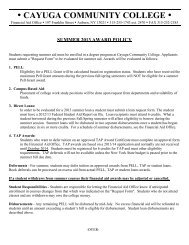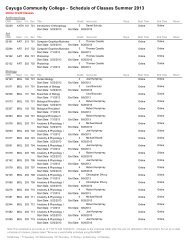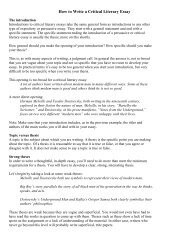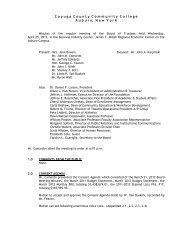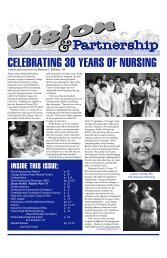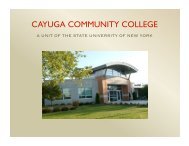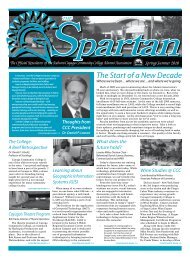citing online sources using mla - Cayuga Community College
citing online sources using mla - Cayuga Community College
citing online sources using mla - Cayuga Community College
Create successful ePaper yourself
Turn your PDF publications into a flip-book with our unique Google optimized e-Paper software.
CITING ONLINE SOURCES<br />
USING MLA<br />
For more extensive rules and examples, consult the MLA Handbook for Writers of Research Papers 7th ed.<br />
or the MLA website (www.<strong>mla</strong>.org ).<br />
THE WORKS CITED PAGE lists all the works from which information has been taken and that have been<br />
cited in the text of the project. This list is placed at the end of a research project.<br />
Guidelines for formatting the works cited page:<br />
Begin the list of works cited on a new page, continuing the page numbers from the body of the paper.<br />
Center the title of the page (Works Cited) an inch from the top of the page.<br />
Entries are arranged in a single list alphabetically by the first piece of information in the entry.<br />
Align the start of each entry with the left margin. Indent any subsequent lines one-half inch (or five spaces).<br />
Double-space the list, both within and between entries.<br />
Guidelines for formatting citations from <strong>online</strong> <strong>sources</strong>:<br />
Provide complete publication information taken directly from the work itself.<br />
Because many <strong>online</strong> <strong>sources</strong> do not supply all desired information, cite what is available.<br />
URLs are not required. If the source might not otherwise be located easily, add the URL after the date of access.<br />
If no author is given, begin the citation with the title (ignore A, An, or The when alphabetizing the list).<br />
If no place of publication is given, use N.p.: • If no name of a publisher is given, use :n.p.<br />
If no date of publication is given, use n.d. • If no page numbers are given, use n. pag..<br />
IN-TEXT CITATIONS (also called parenthetical citations) are used in the body of a research project to<br />
acknowledge the original author or source each time words, facts, or ideas are incorporated from an<br />
outside source. In-text citations identify specifically where in the original work material was found.<br />
Guidelines for creating in-text citations In-text citation example<br />
7.2 The first piece of information given in an in-text<br />
reference must match the first piece of information<br />
given in the corresponding entry on the list of works<br />
cited (usually author or title).<br />
When possible, follow that information with the exact<br />
page numbers from the original source.<br />
Place the in-text citation as near as possible to the<br />
material being cited.<br />
7.3 7.3 When the author or title of a source is used in a<br />
7.4 sentence, the in-text citation only needs the page<br />
7.5 number, if available.<br />
7.4.2 If the source provides fixed paragraph, or section<br />
numbers, include the appropriate abbreviation before<br />
the relevant numbers.<br />
If the source lacks numbering, omit numbers from your<br />
parenthetical references.<br />
The page numbers of a printout normally should not<br />
be cited, because the pagination may vary in different<br />
printouts.<br />
7.4.6 If the works cited list contains more than one work<br />
by the same author, the in-text citation should include<br />
the appropriate title (which may be shortened),<br />
followed by the page numbers.<br />
7.2 If the works cited list contains more than one author<br />
with the same last name, add the first initial to identify<br />
the appropriate author.<br />
This point already had been argued<br />
unsuccessfully (Jones 294-95).<br />
Critics of the concept ask if a large<br />
society would be able to handle the loss<br />
(“Surveillance Society” 115).<br />
The crash of 1929 was one such event<br />
("The Great Depression" 37), but many<br />
others may be considered as evidence of<br />
this type of economic cycle.<br />
Kozol reported this finding in 1989 (2).<br />
In his Autobiography, Franklin notes he<br />
prepared a list of thirteen virtues<br />
(135-37).<br />
This was not unusual for the time<br />
(Mouton pars. 19-20).<br />
Greenpeace notes that this phenomenon<br />
has been seen mainly in North America<br />
(Smith).<br />
This work of Shakespeare's has been<br />
called "a comedy of the grotesque"<br />
(Frye, Anatomy 217).<br />
The loans turned out to be at great<br />
profit to the lender (J. Malcolm 234).
BASIC ELEMENTS OF CITATIONS FOR ONLINE SOURCES<br />
Author or creator. “Title of Webpage, Chapter, or Segment .” Title of Web Site. Publisher or sponsor of Website, Date<br />
of publication. Web. Date of access.<br />
6.7.2.b World Wide Web Site<br />
Quade, Alex. “Elite Team Rescues Troops behind Enemy Lines.” CNN.com. Cable News Network,<br />
19 Mar. 2007. Web. 22 Nov. 2008.<br />
6.7.2.c Book or part of book<br />
Book<br />
Barsky, Robert F. Noam Chomsky: A Life of Dissent. Cambridge: MIT Pr., 1997. Web. 8 May 1998.<br />
Webster, John. The White Devil. N.p.:n.p., 2004. Project Gutenburg. Web. 2 Nov. 2008.<br />
Scholarly Project<br />
Nesbit, Edith. "Marching Song." Ballads and Lyrics of Socialism. Ed. Perry Willett. London, 1908.<br />
Victorian Women Writers Project. Indiana U. Web. 26 June 2002.<br />
6.7.2.d Media<br />
The first element (e.g., director, composer, conductor, performer, title, etc.) depends on the desired<br />
emphasis. You may include other pertinent information, such as the writers, performers, or<br />
producers, between the title and the distributor.<br />
The Great Train Robbery. Dir. Edward Porter. Thomas Edison, 1903. Internet Archive. Web. 9 May<br />
2007.<br />
6.7.4 Resource from library database<br />
Book<br />
Author. “Title of Article or Chapter.” Title of Complete Publication. City: Publisher, date of publication. Name of<br />
database. Web. Date of access.<br />
Norton, Mary Beth. In the Devil’s Snare: The Salem Witchcraft Crisis of 1692. New York: Vintage,<br />
2003. NetLibrary. Web. 17 Dec. 2008.<br />
Article or chapter in a reference source<br />
Fischbach, Michael. "Bush, George Walker.” Encyclopedia of the Modern Middle East and North<br />
Africa. Ed. Philip Mattar. 2 nd ed. Vol. 1. New York: Macmillan Reference USA, 2004. 549-<br />
550. Gale Virtual Reference Library. Web. 2 Oct. 2006.<br />
Eisinger, Chester. "Herzog: Overview." Reference Guide to American Literature. 3 rd ed. 1994.<br />
78- 92. Literature Resource Center. Web. 18 May 2000.<br />
Reprinted periodical article or book chapter<br />
Lee, Hermione. "Little Women." New Republic. 200.15 (1989): 38-40. Rpt. in Contemporary<br />
Literary Criticism. Ed. Jeffrey W. Hunter. Vol. 232. Detroit: Gale, 2007. 35-63. Literature<br />
Re<strong>sources</strong> from Gale. Web. 15 Sept. 2009.
Scholarly journal<br />
Author. “Title of Article.” Tile of Journal. volume.issue (year): pages. Database. Web. Date of access.<br />
Tolson, Nancy. “Making Books Available: The Role of Libraries and Librarians.” African American<br />
Review 32.1 (2007): 9-16. Education Research Complete. Web. 19 Sept. 2008.<br />
Newspaper<br />
Peres, Judy. "Couple’s Divorce Entangles Frozen Embryos." Syracuse Post Standard 7 Aug. 2002,<br />
Final ed.: C12. Newsbank. Web. 12 Dec. 2002.<br />
Magazine<br />
Author. “Title of Article.” Title of Periodical. Date of publication: pages. Database. Web. Date of access.<br />
Weymouth, Lally. "Dangerous Neighborhood." Newsweek 14 Dec. 2005: 31-34. Academic Search<br />
Premier. Web. 2 October 2006.<br />
Opposing Viewpoints<br />
Cotler, Irwin. "Anti-Semitism Is an International Problem." Anti-Semitism. Ed. Laura K. Egendorf.<br />
At Issue Series. Greenhaven Press, 1999. 12-24. Opposing Viewpoints Resource Center.<br />
Web. 18 May 2003.<br />
CQ Researcher<br />
Hatch, David. "Drug Company Ethics." CQ Researcher 13.22 (2003) CQ Researcher Online. Web.<br />
4 July 2005.<br />
6.7.3 Article from a periodical on the Web<br />
Magazine<br />
McGrath, Ben. “Third String Rummy.” The New Yorker. 2 Feb. 2006: n. pag. Web. 26 June 2008<br />
Scholarly Journal<br />
Denning, Peter J. "Business Designs for the New University." Educom Review 31.6 (1996):12-14.<br />
Web. 23 June 1998.<br />
Newspaper<br />
Richardson, Lynda. “Minority Students Languish in Special Education System.” New York Times<br />
6 Apr. 1994, late ed.: A8. Web. 19 Aug. 2007.<br />
6.8.13. E- Mail Message<br />
Boyle, Anthony. "Re: Utopia." Message to Daniel J. Johnson. 21 June 1998. E-mail.<br />
6.8.18 Digital File (such as music, image, or word processed file)<br />
Author, creator, artist. “Title of File.” Title of Collection or Complete Work. Distributor or Sponsor. Date of<br />
creation, Type of File.<br />
Hudson, Jennifer, perf. “And I Am Telling You I’m Not Going.” Dreamgirls: Music from the<br />
Motion Picture. Sony BMG, 2006. MP3 file.<br />
Cortez, Juan. “Border Crossing in Chicano Narrative.” 2007. Microsoft Word file.<br />
Delano, Jack. At the Vermont State Fair. 1941. Library of Congress, Washington. JPEG file.
1 ½<br />
inches<br />
1 inch<br />
Works Cited<br />
"Blueprint Lays Out Clear Path for Climate Action." Environmental Defense<br />
Fund. Environmental Defense Fund, 8 May 2007. Web. 24 May 2009.<br />
Clinton, Bill. Interview by Andrew C. Revkin. “Clinton on Climate Change.”<br />
New York Times. New York Times, May 2007. Web. 25 May 2009.<br />
Ebert, Roger. "An Inconvenient Truth." Rev. of An Inconvenient Truth, dir.<br />
Davis Guggenheim. Rogerebert.com. Sun-Times News Group, 2 June<br />
2006. Web. 24 May 2009.<br />
Gowdy, John. "Avoiding Self-organized Extinction: Toward a Co-evolutionary<br />
Economics of Sustainability." International Journal of Sustainable<br />
Development and World Ecology 14.1 (2007): 27-36. Print.<br />
An Inconvenient Truth. Dir. Davis Guggenheim. Perf. Al Gore, Billy West.<br />
Paramount, 2006. DVD.<br />
Leroux, Marcel. Global Warming: Myth Or Reality?: The Erring Ways of<br />
Climatology. New York: Springer, 2005. Print.<br />
Nordhaus, William D. "After Kyoto: Alternative Mechanisms to Control Global<br />
Warming." American Economic Review 96.2 (2006): 31-34. Print.<br />
---. "Global Warming Economics." Science 9 Nov. 2001: 1283-84. Science<br />
Online. Web. 24 May 2009.<br />
Shulte, Bret. "Putting a Price on Pollution." Usnews.com. US News & World<br />
Rept., 6 May 2007. Web. 24 May 2009.<br />
Uzawa, Hirofumi. Economic Theory and Global Warming. Cambridge:<br />
Cambridge UP, 2003. Print.<br />
1 inch<br />
Bourke Memorial Library <strong>Cayuga</strong> <strong>Community</strong> <strong>College</strong> 2<strong>mla</strong> electronic handout 2000 12/99; rev 12/00; 1/03 md; 5/04 md; corrected 9/09 md; rev 8/10 md<br />
The works cited list<br />
begins on a new page,<br />
with the heading<br />
centered one inch from<br />
the top of the paper.<br />
The first line of each<br />
entry is flush with the<br />
left margin, which is<br />
one inch from the left<br />
side of the paper.<br />
Subsequent lines indent<br />
½ “(or five spaces).<br />
Entries are listed<br />
alphabetically by<br />
authors’ last names. If<br />
no author is given, use<br />
the title as the main<br />
entry.<br />
Double space within<br />
and between entries<br />
throughout the list.<br />
Place the works cited<br />
list at the end of a<br />
research paper.



